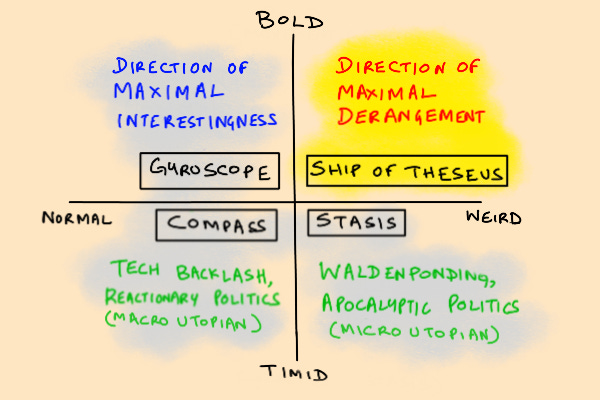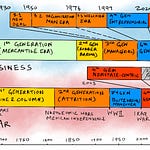In the original Breaking Smart essays, we used the idea of moving in the direction of maximal interestingness, or DOMI, as a way to advance boldly towards the future, and be on the right side of history as software eats the world, and avoid retreating timidly towards the past. In this episode (16 minutes), I want to update that rule. In the Great Weirding, you need to move in the direction of maximal derangement.
Note: the text below is not a transcript, but the rough script I mostly stuck to in the audio version.

The DOMI rule worked for normal conditions. Under the conditions of the Great Weirding, we need a new rule, which I call the direction of maximal derangement. It’s not a new rule per se, but a generalization and porting to a new environment.
The original algorithm was simple: figure out the zone of maximal uncertainty and ambiguity, and then start shipping whatever you ship. Release early release often. Rough consensus and running code.
In the process of exploring that principle, we discovered some subtleties. For example, the idea that you have to give up your credentialist ethos, and adopt a hacker ethos. Or the Chris Dixon principle that what the smartest people do on evenings and weekends, everybody will do in a few years. Or the Peter Thiel idea that you need a secret: something you believe that nobody else believes. Or the idea that you have to earn this secret by figuring out what Balaji Srinivasan called an Idea Maze. Or that this felt like dead reckoning with a gyroscope in a storm.
If you did all this, you would be on the right side of history, moving towards the future, rather than the wrong side. You’d be betting on the world that was being born than the one that was dying. You would be shedding an old identity and growing into a new one.
That rather than navigating with a compass on a clear day, towards a nice tropical island.
The reverse of this was chasing after credentials, going in the direction of certainty, navigating by a compass in clear weather, towards a sunny tropical island. Believing that what you did 9-5 was the important thing. Believing that there was a reliable script you could follow instead of a tricky idea maze you had to figure out. This was, in 2015, the playbook of not breaking smart, the playbook of both the tech backlash, and various flavors of reactionary politics, both left and right.
Now how has that changed? In one sense, it hasn’t changed at all. To head towards the future, you still follow the same algorithm.
But in another sense, an important thing has changed: the algorithm is now running on a different computer. The rule is being applied in a different context, the context of the Great Weirding. So what it feels like when you’re doing the right thing has changed, and if you’re not alive to this sense of orientedness, you might be heading in the wrong direction.
In 2019, the same algorithm works, but “direction of maximal interestingness” has flipped polarity. Instead of pointing at something exciting happening in the external world, it is pointing at something exciting happening in your internal world.
This is the way in which you are reacting to the events of the Great Weirding. And chances are, unless you have been hiding under a rock, you’re suffering from some version of a derangement syndrome, where you feel obsessively drawn towards an object of attention, but you can’t think clearly or effectively around it, and feel a strong urge to retreat for your own sanity and safety. It’s like watching a traffic accident unfolding. Maybe it is Trump Derangement Syndrome. Maybe it is Ocasio-Cortez or Greta Thunberg Derangement Syndrome. Maybe it is Wokeleban Derangement Syndrome, where you are obsessed with how Woke Thought Police is taking over institutions and canceling everyone. Or maybe it is IDW Derangement Syndrome, where you are obsessed with how self-styled intellectual dark web people seem to be normalizing fascist movements while espousing liberal values.
There’s a lot of Derangement Syndromes out there to choose from. It’s a target rich environment. And my suggestion for how to approach the future rather than retreat from it is simple: head in the direction of Maximal Derangement. This means growing in ways that gradually lowers the sense of derangement, restores a sense of orientation and movement, and gives you confidence in your agency again.
In 2015, doing the right thing to be on the right side of history made you feel some mix of exhilaration, fear, superhuman agency, and the sense of being a social subversive. Now, in 2019 it should feel like you’re fighting to reserve your sense of identity and resisting the world being taken over by various zombie armies you detest, while you get increasingly isolated as the only sane person around.
This is the process Jungian psychologists call eating your shadow. It is inner work, rather than outer work. And of course, it is a risky process, because in the process of trying to eat your shadow, you might get eaten by it. You might flip your identity and instead of growing into a new and improved version of yourself, you simply turn into what you hate, and start hating your old self. This is trading one derangement syndrome for another. This is moving sideways. It is like Android turning into the current version of iOS rather than the next version of itself.
Growth has a sense of what some people call include and transcend. You know your new identity is actually working if you get past all the derangement syndromes, and become a new, non-deranged person, and you do it without retreating from the future.
So let’s revisit our algorithm. You still have to do the same things, but in the direction of inner work rather than outer work. You still have to focus on what the smart people do in the evenings and weekends rather than 9-5. You still have to RERO and RCRC, except what you are building is not a software product but a new version of yourself. You 2.0, an identity that compiles and runs in the environment of the Great Weirding.
To stick with the nautical theme in our metaphors for orienting and vectoring yourself, this is not like navigating by either gyroscope of compass. This is like becoming the Ship of Theseus, where you change every part of the ship, while it is in motion, while retaining its fundamental identity. You head in the direction that forces the ship to transform the fastest.
The reverse of this is what I’ve been calling Waldenponding. This is a fate worse than the credentialist approach of 2015, where at least you’re moving in the wrong direction. Instead of heading in the direction of certainty, you’re not moving at all. The compass has stopped working. Plotting a course to a sunny tropical island through calm weather is no longer an option. You are caught in the storm you tried to go around and avoid. So all you can do is take down the sails, shut down the motor, batten down the hatches, and retreat, hoping that the storm won’t smash you to pieces. That’s Waldenponding.
So let’s put the picture together. I have a 2x2 accompanying this podcast. The x-axis is normal versus weird, the y-axis is timid versus bold. The 4 ways of navigating are illustrated on the diagram (the audio has a couple of minutes talking through the diagram, but if you’re reading this, it should be easier to just look at the diagram instead).












The Direction of Maximal Derangement